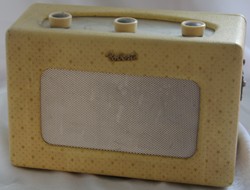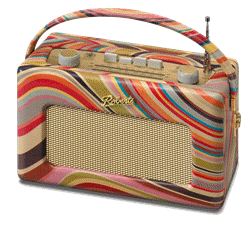Roberts Radio

The Roberts Radio Company is one of the few remaining names from the heyday of the British electronics industry. Roberts established a reputation for quality, as well as producing some outrageously expensive radios in solid gold and mink covered cases. Today the Company produces top quality radio receivers in modern and traditional designs. The Revival 250 (R250), is similar in style to the RT1 from the 50s, pictured above.
Robert Radio - history
Harry Roberts and Leslie Bidmead founded the Roberts Radio Company in 1932. Roberts quickly established a reputation for quality, selling sets to top stores such as Harrods and Army and Navy. Queen Elizabeth, the Queen Mother, bought a Roberts Radio for Princess Elizabeth (now HM The Queen) and later for herself. Roberts won the Royal Warrant in 1955, which it still holds today.

Roberts' first transistor model was the RT1 launched in 1958. It was a well-made set, with a plywood box and covered with leather cloth. One of the designs was gold stars and dots, as seen on the Roberts Radio on this page, above and right. The RT1 was not Britain's first transistor set; the Pam 710, launched in 1956, beat Roberts to that accolade.
The Roberts RT1 was mounted on a small, plastic turntable, which allowed the listener to rotate the receiver to pick up the best signal. This was a feature of quality radio receivers of the time. The original RT1 ceased production in 1965.
Roberts Radios followed the style of the era. In the early 70s, the cases were finished in teak, which was the fashion for quality radio sets.
Another link Roberts Radio had with HM The Queen was provided from an unusual source. Radio sets with VHF aerials were banned in HM Prisons, as the aerial could be used as a weapon. The Roberts Rambler 2, which received only medium wave and long wave and was also built to take hard knocks, was an obvious choice for the discerning prisoner!
Roberts Revival 250
Roberts struggled to stay in business in the 1980s and early 1990s. A chance choice of prop in a Martini commercial, however, changed the brand's fortunes.

An advertisement for Martini, featured one of the original 1950s Roberts sets. It attracted a huge amount of interest, Hundreds of people telephoned the Company to find out if the radio was still available. Harry's son Richard (Dick) Roberts reintroduced the original Roberts RT1 design as the 'Revival' in 1991. His original idea was to sell five hundred sets as a limited edition. Demand for the Roberts Revival was massive and he sold four thousand sets in the first year, in spite of the price tag of over 100.
The Revival was the ideal product for Roberts. Before the Revival, Roberts' range of radios appealed to an increasingly older market. Its classic 70s style sets had received an unhelpful modernisation, making them neither classic, nor modern. They were now something like a pair of classic brogues with modern rubber soles.
Sadly Richard Roberts died in 1991 and the business was put up for sale. Roberts was bought by the electrical giant, the Glen Dimplex Group, in 1994 and Leslie Burrage, a man with forty years' experience in consumer electronics, became its new head. He saw the appeal of the Revival and extended its market by adding new designs and colours.
Now, like the Roberts RT1, the Roberts Revival 250 is available in a variety of colours and patterns. There are some exciting designs such as this psychedelic pattern by Paul Smith, above. Roberts has also embraced the digital revolution and sells digital versions of the classic Roberts Revival, the Revival DB60 in a classy, piano black finish.
More on Roberts Radio
Roberts Radio website: www.robertsradio.co.uk
See also Daily Telegraph article about Leslie Burrage
Your comments on Roberts Radio
"I have owned the Revival 250 in red followed by the Gemini 8 and now the RD60 green. The latter is probably my favorite as it has a clear but natural sound reminiscent of a good valve table radio. The Revival 250 with discreet circuitry had good sensitivity and selectivity but the treble produced glare which could be tiring if listening close" Peter Burgess
"I have just restored an RT1, believe it may be one of the first series. The components are entirely British-made - almost a who's who of the British electronics manufacturing industries that have sadly all disappeared. Still trying to find a suitable battery for it!" Stuart Goodall


Comments